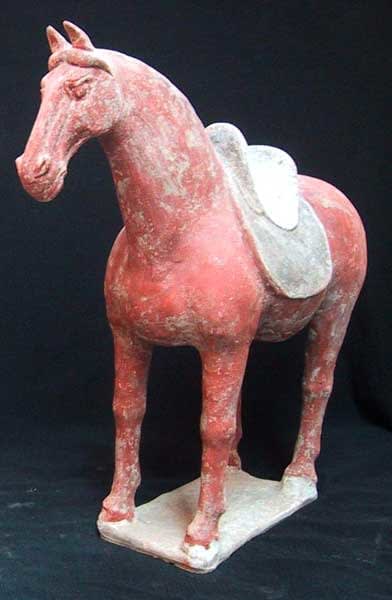Tang Dynasty Funerary Figure of a Horse, 618 CE - 906 CE
Ceramic, Pigment
41.9 x 40 cm
16 1/2 x 15 3/4 in
16 1/2 x 15 3/4 in
X.0406
The great influence of the horse throughout the history of China cannot be underestimated. In fact, the ancient expansion of the Chinese Empire was due in large part to the...
The great influence of the horse throughout the history of China cannot be underestimated. In fact, the ancient expansion of the Chinese Empire was due in large part to the horse. The rapid mobility of horse allowed for quick communication between far away provinces. The importance of the horse in the history and culture of China can be viewed, in part, through the artistic legacy of this great civilization. In sculpture, painting, and literature, horses were glorified and revered.
During the Tang Dynasty, the adoration of the horse can be seen through their burial art. Horse models excavated from mausoleums of the period are among the most splendid and easily recognizable works of Chinese art. This horse has an elegant red coat as well as a painted numnah, or saddle blanket. When gazing into the eyes of this delightful sculpture, we become aware of the reverence the Chinese held for this majestic creature.
The horse here depicted is of a large and spirited breed much sought after by the Chinese. Originating in the grasslands of Inner Asia, such horses were much larger than the pony native to China, hence valued for their speed and nobility.
Indeed owing a horse became a privilege in Tang China when, in 667 an edict decreed that only aristocrats (of both sexes) could ride horses. Therefore the proliferation of earthenware models for the afterlife as status symbols for the aristocratic elite would seem to have been encouraged also by such a strict limitation in life.
During the Tang Dynasty, the adoration of the horse can be seen through their burial art. Horse models excavated from mausoleums of the period are among the most splendid and easily recognizable works of Chinese art. This horse has an elegant red coat as well as a painted numnah, or saddle blanket. When gazing into the eyes of this delightful sculpture, we become aware of the reverence the Chinese held for this majestic creature.
The horse here depicted is of a large and spirited breed much sought after by the Chinese. Originating in the grasslands of Inner Asia, such horses were much larger than the pony native to China, hence valued for their speed and nobility.
Indeed owing a horse became a privilege in Tang China when, in 667 an edict decreed that only aristocrats (of both sexes) could ride horses. Therefore the proliferation of earthenware models for the afterlife as status symbols for the aristocratic elite would seem to have been encouraged also by such a strict limitation in life.



